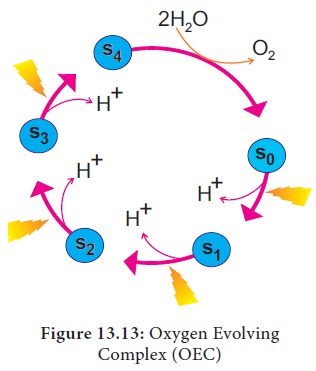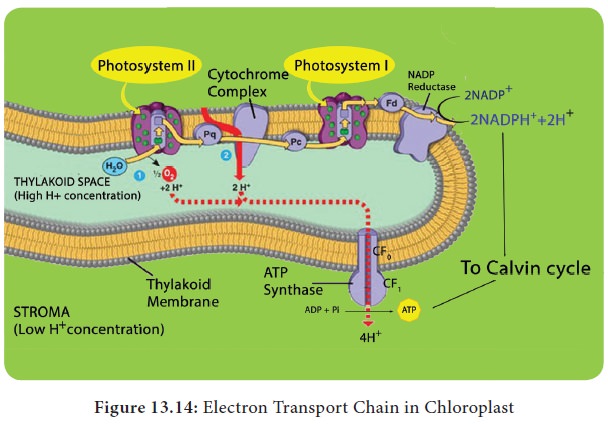Chapter: 11th Botany : Chapter 13 : Photosynthesis
Photo chemical phase of light reaction
Photo chemical phase of light
reaction
In this
phase electrons pass through electron carrier molecules and generate assimilatory
powers ATP and NADPH + H+. Splitting of water molecule generates electrons
replacing electrons produced by the light.
1. Photolysis of Water
The
process of Photolysis is associated with Oxygen Evolving Complex (OEC) or water
splitting complex in pigment system II and is catalysed by the presence of Mn++
and Cl-.
When the
pigment system II is active it receives light and the water molecule splits
into OH– ions and H+ ions. The OH– ions unite
to form water molecules again and release O2 and electrons. Photolysis of water is due to
strong oxidant which is yet unknown and designated as Z or Yz. Widely accepted
theory proposed by Kok et al.,(1970) explaining photo-oxidation of water is
water oxidising clock (or) S’ State Mechanism. It consists of a series of 5
states called as S0, S1, S2, S3 and
S4. Each state acquires positive charge by a photon (hv) and after
the S4 state it acquires 4 positive charges, four electrons and evolution of
oxygen. Two molecules of water go back to the S0. At the end of photolysis 4 H+,
4 e- and O2 are evolved from water (Figure 13.13).


2. Electron Transport Chain of Chloroplast

Electron
transport chain in each photosystem involves four complexes:
•
Core
Complex (CC): CC I in PS I the
reaction centre is P700, CC II in PS II the reaction centre is P680
•
Light Harvesting Complex or Antenna complex (LHC):
•
Two types: LHC I in PS I and LHC II in PS II.
•
Cytochrome b6 f complex: It is the non-pigmented
protein complex connecting PS I and PS II. Plastoquinone (PQ) and Plastocyanin
(PC) are intermediate complexes acting as mobile or shuttle electron carriers
of Electron Transport Chain.
PQ acts
as shuttle between PS II and Cytochrome b6- f complex and PC
connects
•
Cytochrome b6-f and PS I complex.
•
ATPase
complex or Coupling factor: It is found in the surface of
thylakoid membrane. This complex is made up of CF1 and CF0
factors. This complex utilizes energy from ETC and converts ADP and inorganic
phosphate (Pi) into ATP (Figure 13.14).
Related Topics